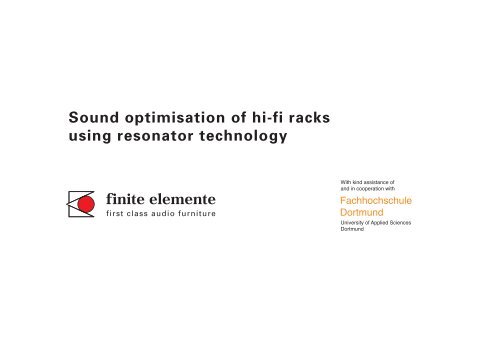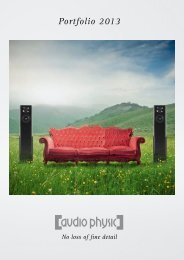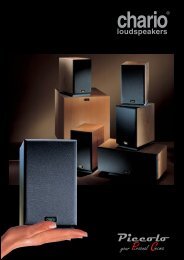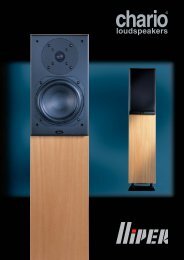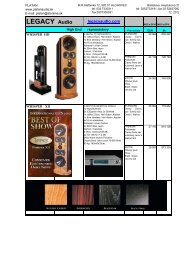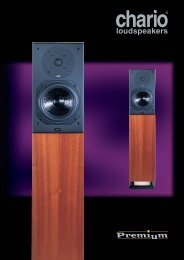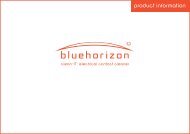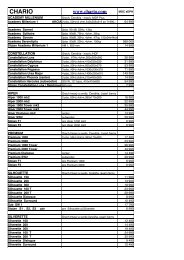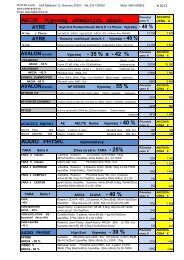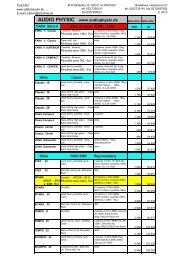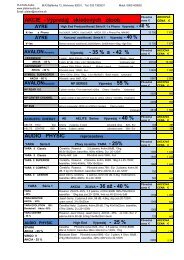Sound optimisation of hi-fi racks using resonator ... - Platan Audio
Sound optimisation of hi-fi racks using resonator ... - Platan Audio
Sound optimisation of hi-fi racks using resonator ... - Platan Audio
Create successful ePaper yourself
Turn your PDF publications into a flip-book with our unique Google optimized e-Paper software.
<strong>Sound</strong> <strong>optimisation</strong> <strong>of</strong> <strong>hi</strong>-<strong>fi</strong> <strong>racks</strong><br />
<strong>using</strong> <strong>resonator</strong> technology<br />
With kind assistance <strong>of</strong><br />
and in cooperation with<br />
Fachhochschule<br />
Dortmund<br />
University <strong>of</strong> Applied Sciences<br />
Dortmund
Reduction <strong>of</strong> oscillation and noise in<br />
technical systems with <strong>resonator</strong>s<br />
In research cooperation with the Dortmund University <strong>of</strong> Applied Sciences <strong>fi</strong>nite<br />
elemente developed a sound <strong>optimisation</strong> <strong>of</strong> the pagode° Master Reference rack<br />
by <strong>using</strong> <strong>resonator</strong>s, relatively small, rod-shaped add-on components that are<br />
installed in the rack und handle triggered resonance oscillations instead <strong>of</strong> the<br />
large surface <strong>of</strong> the component shelves, inaudible due to their small noise<br />
radiation surface area.<br />
Acoustic dummy with PULSE system to<br />
measure airborne sound pressure<br />
T<strong>hi</strong>s patent pending process is based on mechanical energy principles for the<br />
mathematical determination <strong>of</strong> <strong>resonator</strong> geometry. Resonance oscillations <strong>of</strong> the rack<br />
are avoided in that the noise-neutral <strong>resonator</strong>s, w<strong>hi</strong>ch are naturally easier to excite,<br />
dissipate the annoying oscillation energy, converting it into thermal energy.<br />
If a component shelf <strong>of</strong> the rack is triggered by environmental or loudspeaker noise,<br />
then t<strong>hi</strong>s will cause sound-distorting oscillations in t<strong>hi</strong>s system component.<br />
Resonators installed in the component shelf level take over the incoming oscillation<br />
energy and are set in motion in place <strong>of</strong> the component shelf level.<br />
With kind assistance <strong>of</strong><br />
and in cooperation with<br />
Fachhochschule<br />
Dortmund<br />
University <strong>of</strong> Applied Sciences<br />
Dortmund<br />
2
Reduction <strong>of</strong> oscillation and noise in<br />
technical systems with <strong>resonator</strong>s<br />
RED = maximal oscillation, BLUE = no oscillation<br />
Modal analysis without <strong>resonator</strong><br />
Modal analysis with <strong>resonator</strong><br />
Research installation with <strong>resonator</strong><br />
Natural resonance: 125 Hz<br />
Surface oscillates with<br />
strong amplitude<br />
80% strong oscillation<br />
20% oscillation-free<br />
Twin <strong>resonator</strong> determined to 125 Hz,<br />
tensioned on one side<br />
Surface oscillates minimal<br />
Resonator oscillates in place<br />
<strong>of</strong> the surface<br />
90% oscillation-free<br />
10% reduced oscillation<br />
Twin <strong>resonator</strong> determined to<br />
125 Hz on all-round tensioned<br />
metal plate<br />
Result: extreme sound loss caused<br />
by resonance disturbance<br />
Result: considerable sound improvement<br />
through minimized natural resonances<br />
3
Conventional <strong>hi</strong>-<strong>fi</strong> rack<br />
measuring gauge<br />
Design:<br />
conventional design<br />
tubular steel welded or bolted<br />
component shelves in solid MDF<br />
alternative in a different wood type<br />
<strong>fi</strong>lled with sand an/or lead pellets<br />
insuf<strong>fi</strong>cient attenuation and dissipation<br />
Measured results:<br />
uncontrolled oscillation behaviour<br />
<strong>hi</strong>gh number <strong>of</strong> sound-distorting<br />
resonances<br />
too numerous <strong>hi</strong>gh amplitudes<br />
<strong>hi</strong>gh sound pressure values<br />
= clearly audible in music reproduction<br />
Effect:<br />
compressed and contour-less sound<br />
lack <strong>of</strong> transparency<br />
limited three-dimensionality<br />
tonal displacements<br />
insuf<strong>fi</strong>cient resolution <strong>of</strong> detail<br />
limited dynamic scope<br />
4
Pagode Master-Reference without <strong>resonator</strong>s<br />
measuring gauge<br />
Design:<br />
sound-optimised lightweight design<br />
side pillars in solid aluminium<br />
component levels as wooden frame<br />
in solid Canadian maple wood<br />
<strong>hi</strong>gh-absorption shelves with<br />
de<strong>fi</strong>ned coupling<br />
horizontal tensioning <strong>of</strong> the component<br />
levels <strong>using</strong> stainless steel spikes<br />
balanced concept <strong>of</strong> attenuation and dissipation<br />
Measured results:<br />
optimised oscillation behaviour<br />
only six sound-influencing natural<br />
resonances: 220 Hz, 486 Hz, 512 Hz,<br />
550 Hz, 670 Hz, 882 Hz<br />
reduction <strong>of</strong> the <strong>hi</strong>ghest amplitudes<br />
clear reduction in sound pressure values<br />
= scarcely audible in music reproduction<br />
Effect:<br />
open and contoured sound<br />
<strong>hi</strong>gh transparency<br />
extended three-dimensionality<br />
correct tonality<br />
very good precision <strong>of</strong> detail<br />
large dynamic scope<br />
5
Pagode Master Reference with <strong>resonator</strong>s<br />
measuring gauge<br />
Design:<br />
design as Pagode MR<br />
controlled resonance attenuation<br />
with <strong>resonator</strong>s<br />
4 <strong>resonator</strong>s per level, exactly determined<br />
to the natural resonances <strong>of</strong> the test rack:<br />
220 Hz, 486 Hz, 512 Hz, 550 Hz,<br />
670 Hz, 882 Hz<br />
Measured results:<br />
perfectly controlled oscillation behaviour<br />
no sound-influencing natural resonances<br />
drastically minimised sound pressure<br />
values = no longer audible in music<br />
reproduction<br />
Effect:<br />
outstanding open and contoured sound<br />
excellent transparency<br />
holograp<strong>hi</strong>c three-dimensionality<br />
perfect tonality<br />
superior precision <strong>of</strong> detail<br />
exceptional dynamic scope<br />
extreme homogeneity in sound<br />
6
Functional principle <strong>of</strong> the <strong>resonator</strong><br />
measuring gauge<br />
measuring gauge<br />
Oscillation amplitudes wit<strong>hi</strong>n technical systems that are excited by airborne or solid borne noise can be clearly reduced by integrating<br />
or adapting <strong>resonator</strong>s. Resonators are rod-shaped metal components where their <strong>fi</strong>rst natural frequency is matched to the excitation<br />
frequency or the system's natural frequency. Large amounts <strong>of</strong> the kinetic energy – with natural excitation up to 90%, with forced<br />
excitation up to 70% - are inaudibly converted by the <strong>resonator</strong>s into heat. The example shows the amplitude behaviour with and<br />
without <strong>resonator</strong> at 512 Hz.<br />
Design:<br />
metal rod tensioned on one side<br />
in stainless steel cylinder<br />
<strong>resonator</strong> geometry exactly<br />
determined to 512 Hz<br />
stainless steel cylinder bolted with surface<br />
contact to the system to be attenuated<br />
Measured results without <strong>resonator</strong>:<br />
very <strong>hi</strong>gh amplitude at 512 Hz<br />
adjacent areas above and below<br />
512 Hz with increased amplitudes<br />
Measured results with <strong>resonator</strong>:<br />
amplitude at 512 Hz reduced by<br />
a factor <strong>of</strong> 6<br />
bandwidth effect <strong>of</strong> the <strong>resonator</strong><br />
(+_10%) reduces also amplitudes above<br />
and below 512 Hz<br />
7
Modal analysis <strong>of</strong> a conventional <strong>hi</strong>-<strong>fi</strong> rack<br />
Legend:<br />
no oscillation<br />
minimal oscillation<br />
low oscillation<br />
medium oscillation<br />
strong oscillation<br />
maximal oscillation<br />
Measured results:<br />
uncontrolled oscillation behaviour<br />
<strong>hi</strong>gh number <strong>of</strong> sound-distorting resonances<br />
too numerous <strong>hi</strong>gh amplitudes<br />
<strong>hi</strong>gh sound pressure values = clearly audible in music reproduction<br />
Effect:<br />
compressed and contour-less sound<br />
lack <strong>of</strong> transparency<br />
limited three-dimensionality<br />
tonal displacements<br />
insuf<strong>fi</strong>cient resolution <strong>of</strong> detail<br />
limited dynamic scope<br />
8
Modal analysis <strong>of</strong> a Pagode Master Reference<br />
Legend:<br />
no oscillation<br />
minimal oscillation<br />
low oscillation<br />
medium oscillation<br />
strong oscillation<br />
maximal oscillation<br />
Measured results:<br />
perfectly controlled oscillation behaviour<br />
no sound-influencing natural resonances<br />
drastically minimised sound pressure values<br />
= no longer audible in music reproduction<br />
Effect:<br />
outstanding open and contoured sound<br />
excellent transparency<br />
holograp<strong>hi</strong>c three-dimensionality<br />
perfect tonality<br />
superior precision <strong>of</strong> detail<br />
exceptional dynamic scope<br />
extreme homogeneity in sound<br />
9
Fachhochschule<br />
Dortmund<br />
University <strong>of</strong> Applied Sciences<br />
Dortmund<br />
Kirchplatz 16 A<br />
D-59909 Bestwig<br />
Tel. ++49-(0) 2904-4192<br />
Fax ++49-(0) 2904-3580<br />
info@<strong>fi</strong>nite-elemente.de<br />
www.<strong>fi</strong>nite-elemente.de<br />
Labor für Schwingungstechnik und Akustik<br />
Pr<strong>of</strong>. Dr.-Ing. Thomas Borchert<br />
Sonnenstraße 96 - 100<br />
D-44139 Dortmund<br />
Tel. ++49-(0) 231-9112-292<br />
Fax ++49-(0) 231-9112-334<br />
thomas.borchert@fh-dortmund.de<br />
www.fh-dortmund.de


